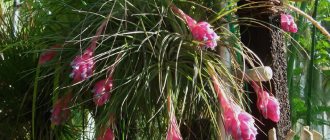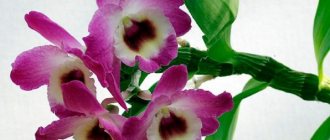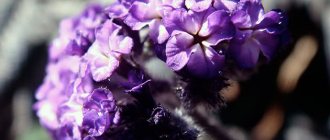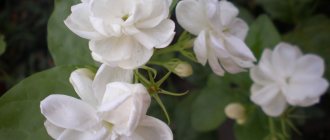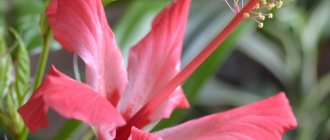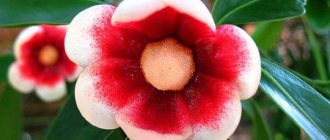Name
Appearance of flowers
Marshmallow is not only a popular sweet, but also the name of a deity from ancient Greek myths. Later, this word began to be used to describe the warm, moist wind blowing from the Atlantic coast. The word "anthos" is translated from Greek as "flower". The homeland of the plant is South America.
Zephyranthes got its name because it blooms when the wind begins to blow zephyr from the Atlantic to the South American continent. The literal translation is “flower of the west wind.”
But zephyranthes also has a nickname - “upstart”. It owes its rapid growth to him: from the moment the peduncle appears until the first flowers bloom, not even a few days pass. The plant has other, more poetic nicknames: “water lily”, “rain flower”, “house daffodil”.
History of flower cultivation and signs
Zephyranthes is a beautiful flowering plant from the Amaryllis family. Not so long ago, the flower was classified as a member of the Liliaceae family. It is not surprising, because zephyranthes and lilies have many similarities.
The flower's homeland is the American tropics and subtropics. Literally translated, the name sounds like “flower of the west wind.” The Americans believed that the west wind brought rain. Therefore, the wind in this direction was considered rainy.
There are many signs and superstitions associated with this flower. Some warn about the dangers of growing Zephyranthes, while others, on the contrary, advise keeping the flower at home.
It is believed that the plant cannot be grown at home for the following reasons:
- Leaves, sharp as needles, pierce the space, disrupting the natural path of circulation of harmonious energy.
- A flower should not be placed in the bedroom, as it causes discord in the relationship of the spouses.
The reasons why you can and should grow upstart at home are the following:
- The flower has a soft energy that has a beneficial effect on the atmosphere of the home.
- Blooming zephyranthes fills the house with joy, gives the inhabitants vigor and optimism.
- Upstart helps to unlock a person's full potential. It also directs thoughts in the right direction, facilitates negotiations with partners, and facilitates the conclusion of profitable deals.
Whether to keep a flower at home or not, everyone makes their own decision. Be that as it may, zephyranthes in bloom pleases the eye and brings only positive emotions. On the other hand, the plant is toxic. Therefore, a house where small children and pets live is not the most suitable place for a plant.
You may be interested in:
Aubrieta: growing from seeds at home Aubrieta is a flower that should definitely decorate your garden plot or home. It is an amazing flower growing...Read more...
Description
Flowering in open ground
Zephyranthes is a herbaceous bulbous plant, a perennial of the Amaryllis family. Up to 40 species are found in nature, living in the tropical and subtropical regions of Central and South America. 10 of them are suitable for home breeding. Residents of these areas happily grow zephyranthes in their garden plots.
The bulbs are small in size, 1-5 cm in diameter, slightly elongated or ovoid in shape and covered with brown husk. The toxins they contain make them unattractive to parasites and pests. Narrow and oblong linear leaves of a dark green hue grow from bulbs.
Variety with pink flowers
Each bulb produces one or several tubular peduncles, their length reaches 30 cm or more. The flowers are solitary, single-row, funnel-shaped, 7-10 cm in diameter. They bloom almost simultaneously with the appearance of the leaves.
In nature, zephyranthes bloom at any time of the year, if the conditions are suitable. The flowers are colored pink, white, scarlet, purple or yellow. Some note that they resemble crocuses.
Characteristics of the variety and species diversity
Zephyranthes is a bulbous herbaceous perennial. Depending on the species, the bulb may have a round or ovoid shape.
The leaf blade is lanceolate, narrow. It reaches a length of up to 30 cm. The leaves of Zephyranthes have a juicy dark green color. The surface of the plates is glossy.
You may be interested in:
How to care for the Decembrist flower? Decembrist is a beautiful and amazing flower that blooms in frosty winters. Therefore, if you want to do...Read more...
The inflorescences are located on long peduncles. In shape they resemble lily and crocus flowers. Depending on the type and variety, the inflorescences can be white, yellow, or different shades of pink. There are also two-color species. Petals can be wide or narrow, with a pointed or rounded edge.
The flower has about 35 natural species and 2 times more hybrid ones. The most common are the following plant species presented in the table.
| Species name | Features of the bulb | Characteristics of the inflorescence | |||
| Shape and diameter, cm | Petal color | Petal shape | Stamens | Flowering period | |
| Atamascian | Ovoid, 2 | Ivory | Wide pointed | Bright yellow, open | March, April |
| Snow-white | Round, 3 | White | Narrow pointed | Lemon, open | July-October |
| Golden | Round-ovoid, 3 | Golden yellow | Wide pointed | Orange, open | December - January |
| Large-flowered | Ovoid, 3 | Pink | Wide pointed | Yellow, open | April-July |
| Multicolored | Oblong, 3 | White with reddish reverse side | Narrow pointed | Yellow, open | January |
| Robusta | Round, 2 | Hot pink | Wide pointed | Orange, open | April-July |
| Pink | Round, 3 | Light pink | Wide rounded | Yellow, hidden | April-July |
The above species are adapted for indoor growing. But there are many species of this plant intended for growing in garden plots.
Difference from Gabranthus
What flowers does gabranthus have - photo
In the Amaryllidaceae family there is a flower similar to zephyranthes - gabranthus. Sometimes they are even called twin brothers. The differences are presented in table form:
| Zephyranthes | Gabranthus |
| Widely open flower corollas. Flowers grow straight | The flowers are half-closed or under-opened, resembling a bell. Grows at a slight angle relative to the peduncle |
| Stamens of equal length | Stamen length varies |
| Wingless seeds | The seeds are thicker and slightly winged |
It is interesting that in English both flowers are called the same: rain lily - “rain lily”.
Origin and description of the species
Zephyranthes is a genus of perennial bulbous plants that belongs to the amaryllis family and has about 90 species, including hybrid varieties suitable for indoor and outdoor use. This amazing flower grows in wet places, swamps and peat bogs of tropical regions of Central and South America, Mexico, Argentina, Brazil, Paraguay and the West Indies. Local residents happily cultivate it in areas near their homes.
Zephyranthes has several “folk” names: upstart, west wind flower, rain lily. The thing is that as soon as the rainy season begins, the previously dormant zephyranthes suddenly suddenly releases arrows topped with flowers similar to lilies, which bloom literally before our eyes. Flowering of the upstart begins unexpectedly and lasts very briefly - on average, 2 days. The plant received its official name, which literally translates as Zephyr flower, due to the fact that its growing and flowering period occurs during the appearance of the western winds (Zephyr is the god of the warm western breeze).
Zephyranthes flowers are crocus-shaped, wide open, with stamens of equal length. The color of the petals can be different - from white to purple. Zephyranthes look best in a group consisting of a large number of planted bulbs. During times of drought, plants are dormant, without leaves or shoots.
Zephyranthes has a “brother” - gabranthus, which is also called the Argentine rain lily. How not to get confused?
The zephyranthes peduncle is always crowned with only one erect flower
Table: differences between zephyranthes and gabranthus
| Zephyranthes | Gabranthus |
| Flowers open wide | Lily flowers, petals form a tube at the base |
| Flowers erect | Flowers are inclined to the stem at an angle |
| Stamens are all the same length | Stamen filaments of different lengths |
| Seeds flattened, wingless | Seeds thickened, slightly winged |
| There is one flower on the arrow | One peduncle can be crowned with up to four flowers |
The peduncle of gabranthus can be decorated with from one to four flowers inclined towards the stem
Gabranthus first belonged to the genus Zephyranthes, but since there are enough differences between these plants, it was separated into a separate genus. Zephyranthes and gabranthus belong to the amaryllis family.
Application and beneficial properties
Use in landscape design
Zephyranthes is a wonderful indoor plant and a convenient “resident” of a garden or summer cottage. Plants are also used to decorate landscapes. But in addition to decorative properties, zephyrantes also have healing properties.
Lycorin, naringin and other alkaloids and antioxidants contained in parts of the plant are used in therapy:
- Oncological pathologies
- Hepatitis and other liver diseases
- Diabetes mellitus
- Tuberculosis.
Marshmallows have also proven effective against colds. The plant is used not only in traditional medical practices, but also in official medicine.
Since marshmallow bulbs are poisonous, they should not be allowed to reach pets or children.
Medicinal properties
The flower has medicinal properties. Due to the content of natural bioactive alkaloids, zephyranthes is included in some medications. Traditional medicine uses the plant's components to treat liver diseases, including some forms of hepatitis.
With the help of the flower, purulent accumulations resulting from inflammatory processes (abscesses) are eliminated. In some countries, the plant is included in medications aimed at combating various forms of tuberculosis and diabetes. There is an assumption about the antitumor properties of marshmallow leaves.
In folk medicine, infusions and decoctions of the plant are used to treat colds, abscesses and purulent sore throat. For colds, the flower is brewed as tea and taken orally. In case of sore throat, gargle with the infusion of the plant. A medicine prepared from the flower bulbs is applied to the boils on the skin.
It is unacceptable to use marshmallows on your own for medicinal purposes, since all components of this plant are poisonous. Improper use poses a threat to human health. To obtain competent advice on the use of the flower as a medicine, you should consult a homeopathic doctor.
Superstitions
Sharp and long leaves of the plant
The flower is surrounded by signs and folk beliefs. For example, it is believed that a plant has strong energy during the growing season - active growth and flowering.
Presumably, zephyranthes helps a person become more relaxed, courageous and self-sufficient. They also say that it strengthens the family, makes relationships more tender and warm.
However, the flower also has a bad reputation. In the teachings of Feng Shui, on the contrary, it is said that an “upstart” causes discord in family relationships, so it is undesirable to keep it at home, especially in the bedroom. Proponents of the doctrine believe that, in general, you should not have plants with long, sharp leaves at home.
When does it bloom and for what reasons does it not happen?
Guzmania - flower care at home
Zephyranthes can bloom at any time of the year. Some species and varieties bloom only in winter, while others only bloom in summer. Various external factors have a great influence on the flowering time: care, climatic conditions, soil quality.
For your information! Most often, the upstart plant begins to produce buds at the same time as leaves.
Flower growers often ask why zephyranthes does not bloom. The first reason for the lack of flowering is improper care or lack thereof. Temperature fluctuations, low indoor humidity levels and lack of fertilizing provoke not only the inability to produce buds, but also the appearance of diseases.
Small flower bulbs
Types and varieties
Species Zephyranthes aurea
There are 38 species of Siferanthes in natural conditions. Thanks to advances in breeding, new varieties have been developed, including multi-color hybrids. Therefore, now there are already about 90 varieties of “upstarts”.
Based on the color of the corolla of the petals, zephyranthes are divided into white-flowered, red-flowered, yellow-flowered and bicolor. Let's look at the most common and interesting types.
Zephyranthes grandiflora
Zephyranthes grandiflora
Grandiflora Zephyranthes (Zephiranthes grandiflora) Can grow up to 40 cm in height. The leaves are also long, thin, up to 20-30 cm.
The color of the corolla is pink, the stamens are orange. The variety can bloom before the onset of cold weather.
Snow-white zephyranthes (Zephiranthes candida)
Zephyranthes snow-white
Snow-white zephyranthes (Zephiranthes candida) Grows up to 60 cm and higher. The bulb is round, approximately 3 cm in diameter. The flowers, as the name suggests, are white with golden-yellow stamens.
Zephyranthes versicolor
Zephyranthes versicolor
Zephyranthes versicolor A typical representative of bicolors. The unusual flowers are colored red-green or white-green on the outside.
Zephyranthes robusta
Zephyranthes powerful
Zephyranthes robusta has large bulbs up to 5 cm in diameter. The variety usually blooms in spring and summer. The flowers are light pink.
Also distinguished:
- Golden Zephyranthes (Zephyranthes aurea)
- Zephyranthes atamasca
- Pink Zephyranthes, or Pink (Lindley Zephyranthes rosea)
How to propagate and replant a flower at home
Zephyranthes very quickly fills the space of the pot, so it needs annual replanting. To improve the aesthetic quality of the plant, several bulbs are placed in one pot. Thus, during flowering, new inflorescences replace faded ones. Some gardeners place different varieties of marshmallows in one container.
There are two ways to propagate the plant at home: seeds and bulbs. Below is a detailed description of each method of breeding new zephyranthes.
Propagation by seeds
Reproduction of upstart seeds involves the following steps:
- Artificial pollination. Using a cotton swab, pollen is transferred from one flower to another.
- Collection of seeds. 2 months after the pollination process, the seeds are considered mature.
- Disembarkation. The collected seeds are immediately planted in the substrate due to the rapid loss of germination. You can use the substrate for an adult marshmallow. The container with seeds is covered with a transparent film on top, simulating a greenhouse.
Marshmallow seeds
- Daily care. The seedlings are irrigated daily with a spray bottle and left for a short time without film for ventilation. After 2-3 weeks, the first shoots will appear.
- Picking. Young upstarts dive only when 2-3 good leaves appear on them.
Flowers bred from seeds bloom only in the third year of life.
Bulbs
Propagating upstarts from bulbs is easy. The process involves the following steps:
- Without any effort, the daughter bulbs are separated from the mother bulbs. The bulbs should come off easily. If they are holding on tight, it means they are not yet ready to live on their own.
Bulbs
- The fracture points are lubricated with crushed activated carbon or charcoal.
- The separated bulbs are planted in the soil mixture, leaving the necks on the surface.
Important!
Experts recommend propagating the upstart bulbously before or after the dormant period of the flower. The plant bulbs should not be disturbed during the flowering period.
Reproduction
Zephyranthes reproduction
The plant can be propagated by daughter bulbs - tubers, as well as seeds. But before you prepare planting material and propagate the plant, you need to take care of a “home” for it.
Selecting a pot for planting
Selection of containers for flowers
To make the blooming zephyranthes look more spectacular and lush, several bulbs can be planted in a container at once. To do this, select a pot that is wide and not too deep. The optimal number of bulbs is from 5 to 10 pieces.
If you plan to plant only one onion, it is enough to choose a pot of a standard shape, but only slightly wider than the onion: too large a container will interfere with the adequate development of the root system. Expanded clay drainage must be placed at the bottom of the pot. The recommended layer width is 1/3 of the height of the pot.
There should be one or more drainage holes at the bottom of the container. If they are not there, choose another pot. You can make holes in plastic yourself.
Soil requirements
Zephyranthes needs loose soil
Zephyranthes will benefit from a loose and well-drained substrate with a high content of nutrients. The acidity pH value should not exceed 6. The soil can be purchased at a flower supply store.
If you prepare the soil mixture yourself, then use it in the same ratio:
- Leaf soil
- Sod soil
- Coarse sand
- Humus
It is also permissible to add one part of peat to the substrate.
Reproduction by children
Plant bulbs
This is the best way to breed marshmallows at home. Daughter bulbs must have roots, otherwise it will be difficult for them to take root in new conditions. The bulbs, separated from the mother bulb, are planted in a prepared container in the amount of 5-10 pieces.
Small specimens are completely grounded. If the neck of the onion is long, it should protrude from the ground.
Then the soil is sprayed with a spray bottle and not watered for several days: during this time, the planting material will undergo primary adaptation. Afterwards, the plants are watered in the usual way.
Choose this method of growing marshmallows if you want quick flowering. A plant grown from seeds will begin to bloom no earlier than three years later.
Reproduction of Zephyranthes
Zephyranthes can be propagated by bulbs or seeds.
Bulbs
Propagating Zephyranthes by daughter bulbs is very simple and effective, so this is the more common method. During a year of active growth, each bulb can form up to 10–15 daughter bulbs. Those with well-formed roots can be separated from the mother specimen and planted in another pot. Be careful not to damage the bulbs or their root system during this procedure. Using a fine spray bottle, moisten the top layer of soil so that water does not get on the necks of the bulbs. Do not water the next few days of planting, let the soil dry out. Now move the pot to its designated place on the windowsill. Then care for the young flower as if it were an adult. Zephyranthes grown from bulbs bloom the very next year.
We remind you that up to 10 bulbs can be planted in one wide but not deep pot.
Growing Zephyranthes from seeds
Growing "Upstart" from seeds is quite possible, but somewhat more difficult. In addition, Zephyranthes grown from seeds will bloom no earlier than in the third year. If you are determined to receive a flower this way, we will help you.
This may be interesting: Calceolaria indoors - growing from seeds and care
Usually the seeds are purchased at a flower shop. But if you want to get seeds from your flower, proceed as follows. First, the flowers should be pollinated. There are probably no pollinating insects in your home, so you will have to do the pollination yourself. Prepare a brush in advance from natural materials (necessarily disinfected). When flowering begins and the pistil blades open slightly, use a brush to transfer pollen from the stamens to the pistils. It can be on one plant, or it can be from neighboring specimens. Cover pollinated flowers with sterile gauze.
If pollination is successful, fruits are formed on the flower - capsules with seeds. After they ripen, you will collect them and plant them immediately, since the longer they lie, the lower their germination rate will be. Prepare the substrate as for planting bulbs. You can add some more peat to it. Sowing is carried out to a depth of 1 cm. The distance between the seeds should be at least 2 - 3 cm. Plant in a box with glass or a container with a lid so that you can create a greenhouse effect.
The place for seed germination should be warm and humid. If necessary, raise the shelter, ventilate and moisten the greenhouse. Shoots should appear in 25 days. Then raise the shelter more often and for a longer time. After a week, the cover can be removed. Move the box to a bright windowsill, where the temperature is about 25 degrees. and diffuse lighting. The onions should be planted in their pots after they have grown and become stronger, preferably in the spring.
Propagation from seeds
Box with seeds
In apartment conditions, this method is rarely used: it is more complicated and gives worse results. In addition, not everyone wants to wait several years for flowers to appear. Finally, for the procedure to be carried out correctly, you must already have flowering marshmallows at home.
For propagation, the owner independently carries out cross-pollination. After two months, the seeds can be planted in the ground: during this time they will ripen in seed pods. A wide, shallow container is suitable for planting. The seeds are lowered into well-moistened soil, evenly distributing them at a distance of a couple of centimeters from each other.
Then they create a greenhouse: cover the pot with cling film. It is kept in a warm, ventilated room and in good light.
Every day the film is removed for 20-30 minutes so that the soil and seeds can “breathe”. In about a month, the first shoots will appear. After some time, they can be separated and placed in other pots.
Seed germination rates vary. There is no need to rush to dig up weak and small seedlings. Let them gain strength.
How to propagate zephyranthes correctly
Planting marshmallows with bulbs is most often done - this method is the simplest, most reliable and self-evident. Each time, replanting zephyranthes into a new container, more or less grown-up children are separated from the mother bulb. Zephyranthes bulbs are planted in the fall; they are planted in a separate container filled with soil of the same composition as for adult specimens. Baby zephyranthes require well-fertilized soil and abundant lighting. Under favorable conditions, young upstarts will delight you with flowers next season.
You can also buy marshmallow bulbs at flower shops. Their price usually fluctuates around 50-70 rubles. However, if you intend to plant many upstart flowers, you should pay attention to wholesale stores where you can purchase a dozen bulbs for about 130-150 rubles.
The seed propagation method is much more labor-intensive and ineffective , and is rarely used at home. This requires artificial pollination and waiting for the seeds to ripen for two months. After this period, the seeds need to be planted as soon as possible, because they quickly lose their viability.
If you are going to buy marshmallow seeds in a store, also pay attention to the expiration date and packaging date of the product - expired seeds may be very ineffective. The price of a bag of seeds averages 50 rubles, 10 rubles per seed.
The soil for sowing is the same as for bulbs, but with the addition of 1 part peat.
The soil needs to be moistened, leveled and seeds sown every 2-3 cm. Cover the container with transparent polyethylene and place it in a moderately shaded place, trying to ensure that the temperature inside the greenhouse is kept at 22 degrees. The soil must be moistened regularly.
Sprouts will appear after 3-4 weeks, but young zephyranthes will bloom only in the third year after planting.
Care
Now - in more detail about what conditions need to be provided for the marshmallow and what its well-being depends on
Lighting
Zephyranthes grows in the tropics and subtropics: this fact determines the selection of maintenance conditions
It is recommended to place the plant on the windowsill of a south-facing window: zephyranthes likes the most light place possible. It is also acceptable to place it on a western or eastern window. But in the north it will be too dark.
Sunlight, even direct light, will not harm it, but it is still advisable to protect zephyranthes from the bright midday sun. In the warm season, the flower is regularly transferred to the balcony or loggia, where it feels great. You just need to protect it from drafts and midday rays.
Temperature: seasonal conditions
During the growing season (spring and summer), heat-loving zephyranthes is comfortable at a temperature of +20-25 degrees
In autumn, a period of rest begins, which continues in winter , until approximately the end of January - beginning of February.
This means that conditions need to be cooler. It is advisable to gradually lower the temperature, starting in autumn, and maintain it at +12 degrees in winter.
Humidity
Sufficiently moist soil
Proper hydration is critical for the plant. In nature, zephyranthes does not bloom in dry times, but begins to grow during the rainy season - it is not for nothing that it is called the “rain lily”.
The flower is watered with soft and clean settled water at room temperature as the top layer of soil dries. Watering is carried out abundant or moderate; The main thing is that the earthen lump does not dry out. But excess moisture from the pan must be removed to avoid water stagnation.
Zephyranthes prefers daily spraying of foliage. It is also recommended to humidify the air around it. For example, you can place containers of water nearby or get an artificial air humidifier in your apartment.
Proper hydration is especially important during the active growth phase. Otherwise, the plant will go into hibernation. The optimal humidity is 80%.
Top dressing
Liquid fertilizer
During the growing season, the plant needs liquid mineral fertilizers, sold in flower shops. They need to be applied twice a month from spring to autumn.
When the zephyranthes blooms, feed it a little more often - once every 10 days, observing the well-being of the flower. When wintering begins, they stop fertilizing.
Transfer
Transplanting bulbs into a new pot
It is advisable to replant Zephyranthes in the spring - in the most favorable conditions. To do this, use strong, healthy bulbs without traces of rot and mold and with their own root system.
Rotten specimens can also be used, but first they are soaked in a fungicidal solution for 30 minutes. The bulbs are planted in a new pot, the voids are carefully filled with fresh substrate.
Caring for Zephyranthes at home
It's time to tell you how to care for the Upstart. This unpretentious flower does not require special attention. Any gardener who wants to have at home an unusual specimen of a green friend that blooms several times a year can cope with its cultivation.
Lighting and temperature
The flower loves bright light without direct sunlight at midday. At other times, sunbathing is the flower’s favorite pastime. Select a place for the pot on the windowsills of all southern directions. In the summer, it can be placed on the balcony or even planted in the garden.
During the dormant period, the plant does not require light; during this time the pot can be placed in a cool, dark room.
The optimal temperature for keeping a flower indoors during active growth should be in the range of 22–29 degrees. During flower dormancy, the temperature should be reduced to 12–15 degrees.
Watering and humidity
In the wild, the flower lies dormant during periods of drought, patiently waiting for the rainy season. Therefore, at high humidity it becomes active, grows quickly and quickly throws out flower stalks and buds. When growing a flower indoors, you need to adhere to this regime.
Zephyranthes should be regularly watered with soft, settled water at room temperature. The top layer of soil should dry out between waterings. During dormancy, when the leaves wither and disappear, do not water the flower, but during flowering, on the contrary, watering should be plentiful. There should be no stagnation of water in the pan, so remove excess water in a timely manner.
If you dry out the earthen ball too much during the period of active growth, the plant will not die, but will go into a dormant period. The next few heavy waterings will bring it out of hibernation. But, these sharp jumps will disrupt the natural growth cycle of the flower and can have a detrimental effect on its further condition.
Therefore, during periods of active growth and flowering of Zephyranthes, regularly moisten its soil, and the humidity in the room should be close to 80%. In this regard, in hot, dry weather the flower needs to be sprayed. In addition, the space surrounding it should be sprayed, it is advisable to place wide containers of water next to the pot, hang wet towels on heating radiators in winter, and ventilate the premises. If you have a household humidifier, eventually turn it on.
Rest period
For different varieties of Zephyranthes, dormant periods occur at different times and their duration varies - from two to three months to six months. Some rest in early autumn until November, others in winter, from December to February. You will see for yourself when your flower needs rest: its leaves will begin to wither and fall off.
This may be interesting: Popular types and varieties of indoor Koleria (Kaleria)
Cut them off carefully so as not to cause the flower to rot. Let the bulbs remain in the ground. Move the pot with the bulbs to a dark, cool (12–14 degrees Celsius) place where the air humidity is about 50%. Do not water, spray or feed the flower for three months until it wakes up. The temperature of Zephyranthes in winter should not be below five degrees, the plant may die.
Dry storage of Zephyranthes bulbs is sometimes used. To do this, remove them from the pot, dry them in air for several days, clean them, then place them in a suitable container and store them in a warm cellar or refrigerator in a vegetable drawer.
If your Upstart does not have a rest period and remains to spend the winter on the windowsill, then do not stop watering. Reduce them to two to three times a month so that the flower does not lose all its foliage.
When the plant wakes up and the first shoots hatch, they return it to a warm room and begin to regularly water and feed it. If necessary, transplant into new pots and soil mixtures. Very soon, the rested and strengthened Zephyranthes will delight you with colorful blooms.
Planting and replanting Zephyranthes
These operations should be done after the end of the flowering period. At this time, the flower is preparing for a period of rest. Its pot is filled with daughter bulbs. Remove the onions from the soil, free them from dead scales, and cut off dry and damaged roots with a clean tool. We recommend treating the bulbs prepared for planting with some fungicide, for example, phytosporin. Apply the solution according to the instructions and place the bulbs there for the required time.
Pot
Usually several bulbs are planted in one pot, during flowering of which a high decorative effect is created. In this case, the planting container should be shallow and wide enough to accommodate five to ten bulbs at once and leave room at the edges for their growth and formation of children. If you only have one onion, then select a planting container such that its diameter is only a few cm larger than the bulb itself.
At the bottom of the flower pot, place a layer of drainage material (small expanded clay, pebbles, shards, pieces of polystyrene foam) of at least 2 cm. It is better if the drainage layer occupies a third of the height of the pot. Check for drainage holes in the bottom. If they are missing, make them yourself.
The soil
For this plant, the soil must be loose and nutritious, with a pH no higher than 6. You can use ready-made universal soil for decorative flowering indoor plants. You can prepare the soil mixture yourself. To do this, mix leaf and turf soil, humus and coarse river sand in equal parts.
Procedure for transplanting bulbs
Place part of the substrate in the pot on the drainage layer. Carefully place the onions prepared for planting on it. The distance between them should be at least three cm. Spread the roots in different directions. Now the bulbs can be covered with substrate. If the onion has a short neck, cover it with the head. If the bulb has a long neck, then let it protrude slightly on the surface of the soil. Place the pot in a bright place where the sunlight is diffused, where it is warm (25–29 degrees) and humid. Gently water the soil, using a fine spray bottle. Do not water the next time until the top layer of soil in the pot has dried thoroughly - otherwise, the bulbs may rot from excess moisture.
There is no need to feed newly planted onions for a month.
Top dressing
Zephyratnes likes to be fed at least twice a month with liquid fertilizer for ornamental flowering bulbous plants. If you don’t find such fertilizers, you can also feed them with complex mineral fertilizers, such as Merry Flower Girl, Agricola or Kemira-Lux. Just read the instructions carefully and do not exceed the dosage.
Organic fertilizers can also be used, but with greater caution, since fresh or poorly rotted manure can lead to rotting of the bulbs. The flower responds well to fertilizing with ash, a nutrient solution from which you can prepare yourself. Add 1 tbsp to 1 liter of water. spoon of ash. Let the solution sit for a couple of days. Then strain and add to water when watering. After Zephyranthes fades and its leaves fade, stop feeding.
Remember that a newly planted or transplanted plant is not fed in the first month, until new leaves appear.
- Do not feed the flower on particularly hot days.
- Do not pour the solution onto dry soil - water it first. This way you will avoid burning the roots.
- For young plants, reduce the dose of fertilizer by half.
- Do not get the solution on the leaves and flowers of the plant.
Flowering period
Like dormant periods, flowering periods for different varieties of Zephyranthes occur at different times of the year. In addition, external factors influence flowering: temperature, humidity, quality and quantity of water during irrigation, lighting and soil nutrition. We have already written about all this above.
In some species, flower shoots appear simultaneously with leaves, in others - after them. Each peduncle ends with only one flower, which blooms for no more than two days. But one onion sometimes produces several arrows, and in each pot there are always several (up to 10) onions planted, which in due time produce their flower stalks. This creates the impression of continuous flowering.
When the flower finishes blooming, cut the flower stalks into a stump of 5–7 cm. Wait until it dries, and only then carefully unscrew it from the soil (bulb). Remove drying leaves and arrows in a timely manner to preserve the decorative appearance of the plant and not provoke the appearance of all kinds of diseases and insects.
Trimming
Zephyranthes. Replanting for further flowering
Rain lily does not need to be pruned. An exception is the removal of yellowed, diseased and dry leaves, dried flowers and buds. This will preserve the decorative properties of zephyranthes.
Diseases and pests
View of a healthy flower
Zephyranthes rarely upsets its owner with illness. Among the common problems for gardeners that arise from improper maintenance:
- Lack of flowering. Among the reasons why zephyranthes does not bloom are lack of light, increased or insufficient humidity. Poorly selected capacity may affect
- Root rot, red rot. Rotting begins due to overwatering of the soil. The plant needs an urgent transplant. Rotting places are cut off and the bulbs are treated with phytosporin or other biofungicides
- Yellowing of foliage. The usual culprit for leaves turning yellow or falling off is a lack of moisture. It is necessary to adjust watering, spray the plant more often
Shchitovka
Pests also do not often attack the plant. Typically parasitic among zephyranthes are:
- Spider mites
- Shchitovka
- Whitefly
- Amaryllis mealybug
Spider mites
The flower withers and withers, sheds its leaves, and refuses to bloom. Parasites feed on the sap from leaves and stems, depriving it of its strength. They settle on different parts of the plant and even between the scales of the bulbs.
To get rid of pests, you need to wash the marshmallow with soapy water, then give it a warm shower. For mild infestations, these measures are sufficient. If there are too many insects, you will have to treat the zephyranthes with special insecticidal preparations. Insecticides are sold in flower and garden stores. You can buy Actellik, Karbofos or Decis.
Careful care will help prevent pests and diseases. Do not forget to spray the plant, fertilize it, and replant it in a timely manner.
Diseases and pests
If not properly cared for, Zephyranthes can be affected by amaryllis scale insects, spider mites and thrips. Treatment is carried out using insecticides.
If "Zephyranthes" does not bloom, what should I do? The reason may be high air temperatures and excessive watering during the dormant period, poor lighting or frequent feeding.
From all of the above, it becomes clear that “Zephyranthes” is a picky plant, and with minimal care costs, it produces magnificent flowering that can perfectly decorate the most modest home.
PHOTO GALLERY
Customer ratings: Be the first!
Zephyranthes diseases and other problems
When growing an upstart, you may encounter the following problems:
- lack of flowering, caused by lack of watering, fertilizing and hypothermia;
- rotting of bulbs due to excessive watering and hypothermia;
- fungal diseases due to infections through cuts. Microbes can enter the soil during planting/transplantation;
- the appearance of pests: spider mites, whiteflies, scale insects.
Note! Zephyranthes very rarely suffers from pest attacks. But if they appear, treatment with insecticides will quickly get rid of this problem.
Why do the leaves of zephyranthes turn yellow?
Often, even experienced gardeners wonder why the leaves of zephyranthes turn yellow. There may be several reasons. First of all, this happens due to lack of watering. Sometimes the reason is more serious, for example, a lack of fertilizer or light. For beautiful green foliage, it is necessary to increase the nitrogen content in the fertilizer. If there is a lack of natural light, it is recommended to use artificial light in the form of lamps.
Upstart popular in home gardening
The plant is unique in its constant flowering even in winter, which is why it is so popular in home floriculture. Moreover, caring for zephyranthes is very easy, even a beginner can handle it.
Characteristics of a houseplant
- Species : Herbaceous perennial bulbous plant. There are more than 90 species in nature, approximately 5-10 of them are indoor.
- Flower color : Mostly white and pink, two-tone colors are less common.
- Leaf color : From dark green to bright green.
- Requirement for sun : Sun-loving.
- Size : 30-40cm.
- Flowering : At any time of the year, depending on the variety.
- Aroma : Barely perceptible, subtle.
Everyone can try to grow these unpretentious and beautiful flowers on their windowsill, and if you choose varieties with different flowering periods, you can admire blooming Zephyranthes almost all year round.
Botanical description and characteristics
The zephyranthes plant lives in America - from the hot southeastern states of the USA and Mexico to the very temperate climate of the Silver River Valley (Rio de la Plata) in Argentina.
Upstarts are well adapted to growing conditions:
- in arid regions, as soon as the heat sets in, the aboveground part dies off, and when the rainy season arrives, zephyranthes emerge from dormancy and begin to bloom;
- They prefer to settle along the banks of reservoirs in the middle latitudes of the Southern Hemisphere and remain green all year round.
Zephyranthes (upstart) is a perennial herbaceous plant, the underground part of which, from a botanical point of view, is a real bulb.
Its structure is the same as that of an ordinary bow:
- the bottom of the upstart is a shortened stem from which thin fibrous adventitious roots extend;
- fleshy scales store a supply of plastic substances, help survive the dormant period and nourish zephyranthes at the beginning of active growth, are modified leaves attached to the bottom;
- rudiments of several peduncles in the center;
- integumentary scales are brown, thin, dry.
The diameter of an adult upstart bulb depends on the species, usually 1-5 cm, but in some hybrids it is larger. Shape – round or slightly elongated.
Zephyranthes leaves emerge from the neck, narrow, long, belt-shaped, similar in appearance to shallots, usually stretching up to 15-30 cm, but not more than 40 cm. The color ranges from herbaceous to dark green.
The peduncles of the upstart are thin, tubular, straight, 25-30 cm high. The color of the corollas depends on the type, white or pink or yellow. The diameter varies from 2.5 cm (Zephyranthes Atamas) to 10 cm (Candida).
The shape of the flowers is symmetrical, the petals are elongated-oval, tapering at the end and at the base. They are usually located one at a time on the stem, last for 2 days, and are similar to daffodil, crocus, lily or daylily. Species zephyranthes always have 6 petals, the stamens are long, golden, with large oblong anthers.
Upstart flowers get their name due to the fact that the buds extend and open fully within just a day.
In nature, some species bloom in the spring, before the leaves appear, others - when narrow feathers grow, and others, for example, White Zephyranthes - at the end of summer or early autumn. Sometimes flowers replace each other continuously for 4-5 months. When grown in pots, the buds appear regardless of the season; in late-flowering upstart species, even in winter.
In order for a houseplant to set seeds, artificial pollination is needed. They are quite large, similar to half a brown disk, slightly tapering at one end, with wing-like appendages. The upstart fruits are tricuspid capsules that ripen for 2 months. Seeds lose germination quickly.
Zephyranthes blossom
Violet - flower care at home
With several types of upstarts, you can see flowering plants all year round, as some varieties bloom for only one season, others for two seasons. The flowering of the plant also depends on care.
Important information! Often, zephyranthes buds form at the same time as the leaves.
If zephyranthes does not receive regular care at home or external conditions are not favorable enough for it, then it simply will not bloom. The upstart does not tolerate sudden changes in temperature or low room humidity. This information is for those who are wondering why indoor zephyranthes does not bloom. In addition, the plant will not bloom if you do not apply fertilizer, because fertilizing stimulates the formation of buds.
